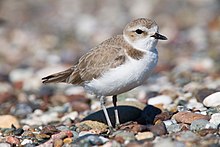Snowy plover
| Snowy plover | |
|---|---|
 |
|
| Snowy plover near Cayucos, California | |
| Scientific classification | |
| Kingdom: | Animalia |
| Phylum: | Chordata |
| Class: | Aves |
| Order: | Charadriiformes |
| Family: | Charadriidae |
| Genus: | Charadrius |
| Species: | C. nivosus |
| Binomial name | |
|
Charadrius nivosus Cassin, 1858 |
|
The snowy plover (Charadrius nivosus) is a small wader in the plover bird family. It breeds in Ecuador, Peru, Chile, the southern and western United States and the Caribbean. Long considered to be a subspecies of the Kentish plover, it is now known to be a distinct species.
Genetic research published in 2009 strongly suggested that the snowy plover is a separate species from the Kentish plover, and by July, 2011, the International Ornithological Congress (IOC), and the American Ornithologists' Union (AOU) North American committee have recognized them as separate species. Other taxonomic committees are reviewing the relationship.
Physically, snowy plovers are shorter-legged, paler and greyer above than its Old World sister species, and breeding males lack a rufous cap. The eye mask is also poorly developed or absent.
The snowy plover breeds on sandy coasts and brackish inland lakes, and is uncommon on fresh water. It nests in a ground scrape and lays three to five eggs.
The breeding birds in warmer countries are largely sedentary, but northern and inland populations are migratory, wintering south to the tropics. Food is insects and other invertebrates, which are obtained by a run-and-pause technique, rather than the steady probing of some other wader groups.
The snowy plover breeds from Texas and Oklahoma west to California and up the coastline to Oregon and Washington, with the coastal form's primary breeding concentration in central and southern California. On March 5, 1993 the western snowy plover was listed as a threatened species under the Endangered Species Act of 1973. As of June 19, 2012, the habitat along the California, Oregon, and Washington Coasts have been listed as critical.
...
Wikipedia

